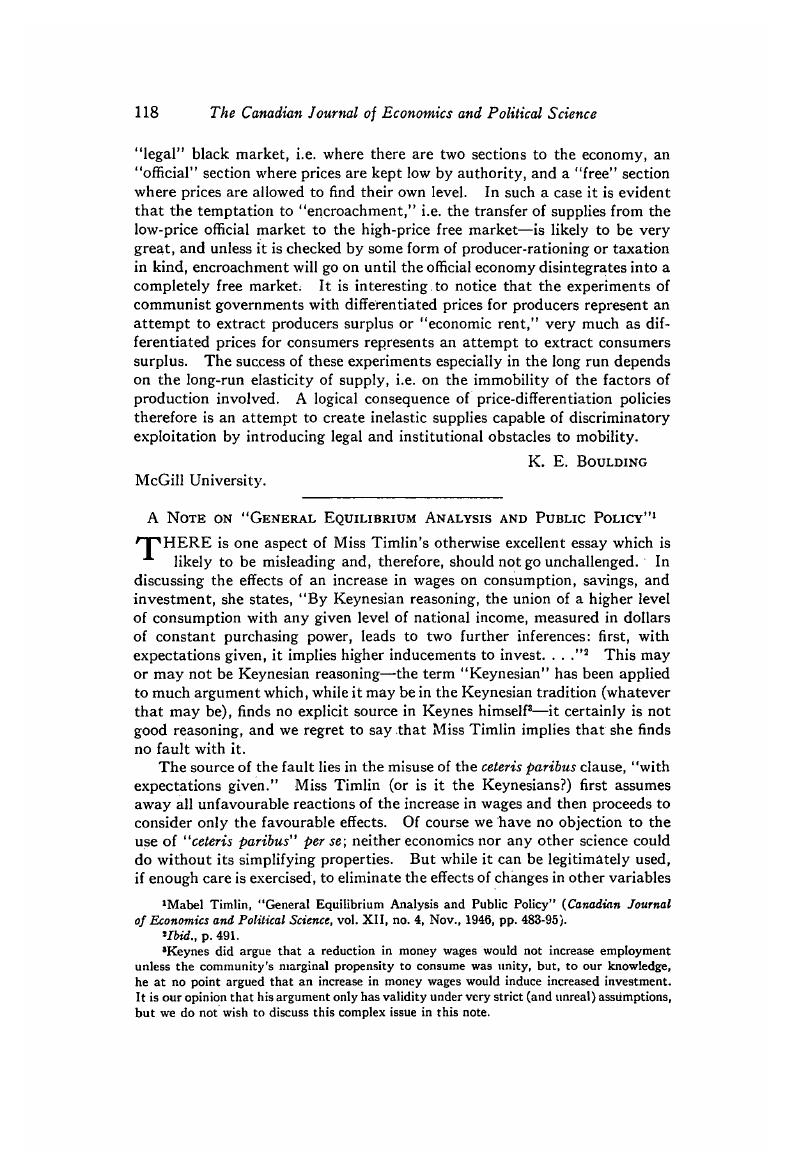No CrossRef data available.
Published online by Cambridge University Press: 07 November 2014

Mabel Timlin, “General Equilibrium Analysis and Public Policy” (Canadian Journal of Economics and Political Science, vol. XII, no. 4, Nov., 1946, pp. 483-95).
2 Ibid., p. 491.
3 Keynes did argue that a reduction in money wages would not increase employment unless the community's marginal propensity to consume was unity, but, to our knowledge, he at no point argued that an increase in money wages would induce increased investment. It is our opinion that his argument only has validity under very strict (and unreal) assumptions, but we do not wish to discuss this complex issue in this note.
4 The extent to which the concept of equilibrium retains any meaning in aggregative analysis of this type has been discussed in some detail by Fellner, William J. (Monetary Policies and Full Employment, Berkeley, 1946, chap, I passim and especially pp. 7–15).Google Scholar We justify our brash use of the concept herein on the grounds that in a note of this length one can only criticize the application of Keynesian analytic tools, not the tools themselves.
5 Since Miss Timlin has specifically excluded the possibility of price increases (by means of her “selective controls”) she cannot have assumed that the depressive effect of increased costs is offset by increased prices.
6 This greater apparentness may be of crucial significance, for the degree of certainty with which the business man views a change, determines in large measure the effect which it will have on his decisions.
7 If we wish to determine the effect on national income we must also consider the fact (mentioned by Miss Timlin) that “a lower level of net new investment is required to hold any given level of national income” ( Timlin, , “General Equilibrium Analysis,” p. 491).Google Scholar So long as the depressive effect on investment does not lower it below this “new” level, the effect on income will be expansionary; if it takes investment below the new level, it will be depressive.
It should be added that it is quite possible that the time relationship assumed in our argument might be reversed, and that the transition effects might be stimulative. That is, if investment is continued at high levels temporarily (because it is more profitable to complete partly finished projects than to abandon them) and consumption increases rapidly, the stimulating effect of the increased consumption may be so great (owing to a high “leverage coefficient”) that considerable investment is induced and the decline in investment which would otherwise have taken place once the current investment projects were brought to completion is more than offset. Even in this event, the stimulating effects could only be transitional; the “equilibrium” effect is necessarily depressive if there is no change in other autonomous variables.
8 Miss Timlin has shown that even this conclusion is subject to considerable qualification.
9 See, for example, Viner, Jacob, “Mr. Keynes on the Causes of Unemployment: A Review” (Quarterly Journal of Economics, vol. I, no. 51, 11, 1936, pp. 160–3).Google Scholar
10 In view of Miss Timlin's frequent references to general equilibrium and to Lange's, Oscar Price Flexibility and Employment (Bloomington, Indiana, 1944, pp. 7–28 Google Scholar; see especially his p. 12, n. 16) one might hazard the guess that she believes that a “negative monetary effect” or a “highly elastic effective expectation of discounted future prices” (to use Dr. Lange's terminology) will be operative, but he offers no support for such a belief.